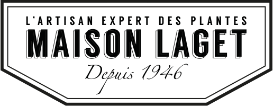ESSENTIAL OILS - GENERAL INFORMATION
The use of essential oils requires a certain number of guarantees with regards to quality control, as both safety of use expected results depend primarily on the quality of the essential oil used. Our essential oils perfectly meet and in many cases surpass the criteria that you must insist upon:
Identification & Origin
- We source our supply from privileged partners, small growers and local distillers around the zone of geographical culture of the plant wherever possible.
- The vast majority of our essential oils are sourced from organic farming or at the very least from cultures that respect the principles of organic agriculture. Conventional essential oils are derived from wild plants or traditional crops that respect the environment and exclude or limit the use of synthetic pesticides or fertilizers.
- MAISON LAGET ( whose company name is Compagnie des Arômes & Cosmétiques SAS) is compliant with ECOCERT France standards thereby demonstrating its commitment to respect the organic production methods and processes.
Knowledge and respect for the nature of essential oils
The organoleptic and therapeutic properties of an essential oil vary according to the nature of the plant used. In order to guarantee quality and efficacy, the raw materials must be precisely identified according to 3 fundamental criteria:
1 / The exact botanical species (Latin name)
2 / The plant parts used (leaves, flowers, roots ...)
3 / The biochemical specificity known as chemotype ( in other words the dominant molecules) which can vary greatly according to the time and place of harvest.
These criteria will determine the therapeutic properties of an essential oil, and as a consequence the precise use that can be made of it , whilst making it possible to obtain - and make it possible to obtain E.O.B.B.D. certified status (Essential Oils Botanically and Biologically Defined).
For completeness of information and peace of mind, you should know that all of our essential oils are E.O.B.B.D. certified.
1 / Exact Botanical Specification:
To avoid any confusion that could be dangerous for health, the distilled plants must be identified by their Latin name, which is composed of two parts: the genus and the species (and sometimes the the sub-species). Sometimes the name or initials of botanist who ‘discovered’ (responsible for the initial description) the plant can be added (i.e. L. for Linné). Often-times the distillation of plants from the same Species (or even subspecies) resultin essential oils of completely different chemical compositions:
An example of a genus: Lavandula (Lavender).
An example of a species: True Lavender (Lavandula angustifolia), which is relaxing and regenerative or Aspic Lavender (Lavandula latifolia), which is specifically anti-toxic
An example of a subspecies: Bergamot (Citrus aurantium subsp. bergamia) and Petitgrain (Citrus aurantium subsp. aurantium).
2 / Plant parts used:
Even with the same plant as a source, each plant part will still provide an essential oil with different qualitative and quantitative properties. ( i.e. an essential oil extracted from the bark of Ceylon cinnamon (Cinnamomun zeylanicum) has far more powerful anti-infective properties than an essential oil distilled from the leaves.
3 / Chemotyped essential oils:
The same plant growing in different locations will also secrete very different chemical ingredients depending on the sunlight, climate, soil composition and altitude. These variations in composition determine the biochemical specificity of the plant and are referred to as chemotypes (or chemotype). They are determined in a laboratory by gas chromatography( a common type of chromatography used in analytical chemistry for separating and analysing compounds that can be vaporized without decomposition).
Thus, 3 different essential oils are extracted from Rosemary, depending on whether it is harvested in Morocco (eucalyptol is dominant and therefore it has expectorant properties), in Provence (camphor is dominant and therefore it is a muscle relaxant) or in Corsica (verbenone is dominant and therefore it is a hepatic stimulant). Similarly, the aroma of an essential oil distilled from thyme or lavender picked at high altitudes will be less powerful than that of the same plants picked on the plains.
Chemical purity
A quality essential oil must also be guaranteed 100% pure and natural:
- it must come from the one and only variety corresponding to the botanical name of the plant mentioned on the label.
- it must not have undergone any transformation (colouration, discolouration, deterpenation) or denaturation, reconstitution or alteration due to the addition of other natural or synthetic substances which risk changing its properties, making it allergenic and even toxic to the body.
The only way to verify the above is in a laboratory by gas chromatography to determine molecular content and biochemical composition.
All of our essential oils are all guaranteed 100% pure and natural.
How essential oils are extracted
Our essential oils are obtained obtained by a traditional slow steam distillation extraction system using a first cold pressed mechanical process, or by the cold expression of the zest for citrus fruits.
There are a few exceptions. For example, to obtain Cade oil, also known as juniper tar, the trunk and roots are subject to heat pyrogenation, an ancestral method of heating the wood at 250 ° C in a sealed oven to obtain the tar.
The use of these traditional methods is the most natural way possible to obtain the essential oils.
With few exceptions however, the 2 main processes for extracting an essential oil are:
1 - Slow steam distillation which extracts the bioactive compounds of the plants. This traditional extraction process captures the aromatic substances through the use of water vapour at controlled pressures by rupturing the secretory cells ( essence pockets) of the plant containing the aromatic molecules.
The steam loaded with aromatic molecules then passes through a coil which is immersed in a cold water tank and becomes liquid (this is the ‘distillate’ commonly called floral water).
Essential oil is ultimately separated from the aqueous blend by its difference in density as essential oil is generally lighter than water. A small amount of essential oil remains as it is solubilised in the aqueous blend. This concentration varies according to the plant species, from trace elements ( i.e. Linden contains almost no essential oil) to 2 or more rarely 3 grams per litre.
This aqueous blend is the hydrolate, more commonly known as floral water.
This slow distillation at low pressures is done at the expense of speed and volume and therefore profitability. It does however ensure the best quality because the vapour’s slow passage through he heart of the plant matter ultimately impregnates and loads with a maximum amount of aromatic molecules which are captured and stored in the essential oil giving it an exceptional richness and aromatic fragrance.
2 - The cold expression expression or scarification of the zest is a method reserved for citrus peels (orange, lemon, mandarin etc.). This is a mechanical process to break the secretory cells and recover the liquids and is performed at room temperature. It consists in lacerating (multiple small cuts) the zest (pericarp) of the fruit, whereby the contents of the secretory sacs are recovered by exerting an abrasive action on the whole surface of the fruit beneath a current of water. Once the solid waste is removed, the essential oil (or essence) is separated from the aqueous blend in a centrifuge and filtered out.
To obtain Cade oil, also known as juniper tar, the trunk and roots are subject to heat depyrogenation, an ancestral method of heating the wood at 250 ° C in a sealed oven (today sealed vats are used) to obtain the tar which oozes on the walls of the oven and is then recovered.
In France, since the XVIII century and probably before that, Cade oil has been traditionally harvested and distilled in Hérault. This practice was widespread throughout the Mediterranean basin, where the oil was sought for its healing properties, which were historically particularly appreciated by goat and sheep farmers.
Did you know?
Many factors influence both the chemical composition of a plant but also the amount of essence extracted (land, climate, season, altitude, humidity...). Essential oil yields are variable and difficult to quantify from one species to another which explains differences in prices.
To extract 1 kg of essential oil requires:
- 5,000 to 10,000 kg of Lemon balm
- 150 kg of True lavender
- 7 kg of Cloves
Traceability and Best Before Dates
We rigorously and systematically check each batch entering our workshop so as to accurately list the origins and characteristics of plant and packaging materials (bottles, caps...).
This 360 degree traceability is referenced by a batch number assigned to each product allowing the complete and perfect identification of each component of the product. With this batch number, we are able to trace each component back to our different suppliers, who in turn can do the same throughout their own manufacturing circuits.
On each product, a Best Before Date informs you of the optimum and recommended lifespan of each product.
Uses of essential oils
We invite you to consult our technical data sheets detailing specific uses and precautions for each essential oil. You will also find below a series of general indications that will allow you adopt a correct overall approach in the use of essential oils in aromatherapy.
Obviously, health and well-being depend primarily on the respect of the laws of nature in all areas of life and it is no different with essential oils that may be used to promote the smooth functioning of your body and stimulate individual functions or organs. They do not generate dependence, however due to their extreme concentration, they must be used with the greatest of care and caution, even at low doses. Essential oils are not drugs and should never be considered as such.
Topical uses:
Topical administration or topical application means application to body surfaces such as the skin or mucous membranes of one or more essential oils (pure or diluted in a carrier oil) to treat ailments. Our Pure Complexes can also be used in massage or mixed with a few drops of vegetable oils.
Some essential oils can be highly dermocaustic. To avoid any risk of irritation and even burns, these essential oils must be diluted in a vegetable oil before they are applied on the skin. Sweet almond oil is neutral and is recommended as the go-to carrier oil, but any vegetable oil can be used. In many cases, the vegetable oil that you choose as a carrier oil will have properties of its own that complement and even reinforce the action of the essential oil; a great example is Everlasting Helichrysum macerate which is added to essential oils when treating circulatory disorders.
So which essential oils require dilution?
Dermocausticity – weak to none:
Bergamot - Rosewood - Cade Juniper- Noble Chamomile - Caraway - Gum Rockrose - Cypress - Eucalyptus globulus - Eucalyptus radiata - Sweet Wintergreen (or Wintergreen) - Juniper - Rose Geranium - Helichrysum – Aspic Lavender - Lavender – Hybrid Lavender - Lemongrass –Peppermint - Myrtle - Palmarosa - Ravintsara - Camphor, cineole or verbenone Rosemary - Saro (or Mandravasarotra) - Tea tree - Ylang-Ylang.
Dermocausticity – possible:
Dill - Exotic Basil - Lemon - Lemongrass - Tarragon - Ginger - Green Mandarin - Sweet Orange - Marjoram - Niaouli - Siberian Pine - Sandalwood - Thyme linalool or thujanol.
Dilute up to 20% in a carrier oil.
Dermocausticity – high:
Cinnamon - Clove - Oregano - Savory - Thyme thymol.
Dilute between 5% minimum and up to 20% in a carrier oil.
Inhalation & diffusion:
The inhalation of the vapours of 2 to 3 drops of essential oil or pure complex applied to the surface of a bowl boiling water or sprinkled on a handkerchief. Our Essential Oil Evaporative Diffusers are able to preserve the therapeutic properties of the essential oils.
Oral use:
Some essential oils are traditionally mixed with honey, sugar, or a vegetable carrier oil and ingested 2 to 3 times a day (1 to 2 drops). Of course, the amounts used depend on the essential oils chosen and you should always be aware of the possible toxic and dermocaustic effects of a number of essential oils. The oral ingestion of essential oils is always recommended for short periods only and always requires medical advice and a prescription.
For bathing:
Relaxing, soothing or purifying essential oils such as our Pure Complexes can always be used for bathing so long as you abide by one simple rule: always use a dispersant!
To safely enjoy the properties of the essential oil you have selected, blend the essential oil with shower gel, bath foam, liquid soap or even coarse salt before running your bath. As a general rule, you should allow for a dispersant to essential oil ratio of 4 to 1 and should not exceed 10 drops of essential oil per 100 litres of water for adults.
Cosmetic & Other uses:
Dilute 1 or 2 drops in a care cream, in your sauna bucket or in your culinary preparations. Consider deodorization, cleaning, air freshening or as an effective insect repellent….
For further and more detailed information on the properties and uses of essential oils for your health well-being and beauty, please consult our aromatherapy reference books.
PRECAUTIONS FOR THE USE OF ESSENTIAL OILS
In view of their concentration, the use of essential oils requires the respect of a number of basic rules in order to extract maximum benefits from their properties whilst avoiding any inconvenience that may arise due to misuse.
Although the vast majority of essential oils are of food grade quality, we do not recommend their ingestion without prior medical consultation.
1. We recommend that you first perform a tolerance test by applying pure or diluted essential oil on the inside of the wrist or elbow. Should your skin become red or irritated you should avoid any further application.
2. Essential oils are not water soluble and therefore if added directly to your bath they will float on the surface and may cause severe irritation upon contact with the skin or mucous membranes. What you should do is add the essential oil to a dispersant such as your shower gel, liquid soap or even coarse salt before running your bath. As a general rule, you should allow for a dispersant-to-essential oil ratio of 4-to-1 and should not exceed 10 drops of essential oil per 100 litres of water for adults.
3. You should never apply essential oils directly on mucous membranes, your eyes or eye contours, ears or nose. In case of accidental contact, rinse thoroughly with abundant water and clean the area with a cotton swab moistened with a vegetable oil. Seek medical advice if irritative symptoms persist.
4. Some essential oils are dermocaustic (they act as a skin irritant and can cause burns to skin and mucous membranes) and their use requires systematic dilution in a carrier oil.
5. Avoid the use of photosensitizing essential oils before sun and light (UV) exposure.
6. Peppermint (Mentha piperita) essential oil for example should not be applied over large areas as it activates the cold-sensing nerves making the area go numb. It is not recommended for use in pregnant women, babies or young children as there is a risk of pharyngeal spasms due to its hypertensive properties. More generally, a number of essential oils have special precautions for use that you must be aware of before application.
7. Never use essential oils on young children (under the age of 3) unless prescribed by a medical professional and you should only use essential oils with the utmost caution in children under the age of 12. Their use is not recommended for pregnant or breastfeeding women and for people with serious health issues.
8. Do not leave essential oil flasks or droppers within reach of children.
9. Essential oils are not drugs and should not be considered as such. Do not combine essential oil treatments with other drug treatments.
10. If in doubt, always seek medical advice.
* Disclaimer: the information available here and in our general documentation does not claim to be exhaustive and is made available for information purposes only. In no case does it replace the medical advice necessary in the establishment of a diagnosis and in assessing the severity of a pathology. This information drawn from research conducted by healthcare professionals is the synthesis of our research on aromatherapy and includes reference books by Pierre Franchomme and Dr. Daniel Pénoël: "Precisely Aromatherapy" Roger Jollois Editor, of Aromatherapist pharmacist Dominique Baudoux: "Aromatherapy, healing with essential oils" (Editions Amyris), Dr. Zhiri and Dominique Baudoux: "Scientific aromatherapy - chemotyped essential oils and their synergies" (Editions Inspir), Dr. Jean Valnet: “The Aromatherapy Pocket Book”, Danielle Festy, pharmacist:" My Bible of essential oils ", Fabienne Millet, pharmacist: "The great guide to essential oils", (Marabout.) This content is not intended to be a substitute for professional medical advice, diagnosis, or treatment, and does not constitute medical or other professional advice. Maison Laget shall not be liable for any direct, indirect, consequential, special, exemplary, or other damages arising therefrom.




